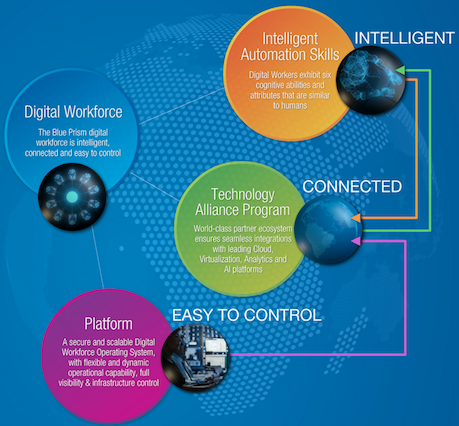
By Don Horne
Robots on the assembly line were designed to free human beings from boring, repetitive work. Now, robotic process automation, or RPA, is being touted as freeing the back-office of the same boring, repetitive tasks.

Vishal Vaidya
Vishal Vaidya, the director of professional services with Bits In Glass, sees investing in RPA as providing companies with a competitive advantage by reducing the time and money spent on repetitive tasks – while allowing employees to spend their time working on high-value tasks that engage them at a higher level, which ultimately benefits the entire company.
Vaidya sees robotics becoming more commonplace – and necessary – in the automation of process manufacturing, with RPA taking off in all aspects of the industrial processing sector.
“Within the manufacturing industry, RPA is most effective in automating crucial back-office processes like email and paperwork approvals, procurement tasks, supplier communication, inventory reporting, processing orders and payments, and more,” Vaidya says. “RPA is also effective on the production floor, using automated digital workers to help manufacturers streamline the order fulfillment, production, and shipping processes. Digital workers can manage inventory in real-time, notifying employees when inventory is low or missing.”
As for Canadian companies currently behind on adopting RPA, there is an increasing excitement around it.
“There seems to be a lot of confusion and misconceptions around what RPA can do that can lead companies down the wrong path and cause them to lose steam in their RPA journey,” Vaidya points out. “For example, RPA is often confused with cognitive automation. Cognitive automation augments RPA, but RPA is focused on deterministic rules-based processing.”
While many harbour fears of a recession looming on the horizon, there shouldn’t be a reluctance to invest in RPA.
“Investing in RPA gives companies a competitive advantage by reducing the time and money spent on repetitive tasks; allowing employees to spend their time working on high-value tasks that engage them at a higher level, ultimately benefiting the company,” he says. “RPA can be implemented quickly, which gives companies a faster return on their investment than what could be achieved through traditional workflow and process improvements.”
While many harbour fears of a recession looming on the horizon, there shouldn’t be a reluctance to invest in RPA.
“Investing in RPA gives companies a competitive advantage by reducing the time and money spent on repetitive tasks; allowing employees to spend their time working on high-value tasks that engage them at a higher level, ultimately benefiting the company,” he says. “RPA can be implemented quickly, which gives companies a faster return on their investment than what could be achieved through traditional workflow and process improvements.”
A typical medium-sized implementation may take two-to-three months, with many companies reporting that they are seeing a return on their investment within a year of deployment, sometimes as soon as six months.
Unlike other traditional workflow improvements, RPA requires minimal IT resources. Programming digital workers is simple, and doesn’t require IT development expertise. Plus, the technology can work on back-office tasks 24 hours a day, seven days a week, 365 days a year, unlike a human employee.
“Overall, RPA increases efficiency and speeds productivity, has around the clock operational ability, reduces risk, has better control, governance, and security, enhancing company insight, and decreasing costs, ultimately positively impacting a company’s bottom line.”
Within manufacturing and processing, RPA can be used to streamline supply chain management by implementing digital workers to automate and improve communications, inventory processes, procurement and order processing.
 RPA can also be used to help manufacturers reduce compliance costs, by automating and streamlining how companies track and manage regulatory requirements, Vaidya says.
RPA can also be used to help manufacturers reduce compliance costs, by automating and streamlining how companies track and manage regulatory requirements, Vaidya says.
“RPA also plays a major role in helping manufacturers accelerate their production, by enabling the company, its systems and its employees to access the data they need to manage production,” he adds.
RPA transforms the back-office for companies by automating and streamlining critical and repetitive business processes and tasks. RPA digital workers can help companies onboard and manage vendors, customers and employees, process accounts receivable, payable, and payroll, review financial logs for fraud alerts, schedule and track shipments, create and deliver invoices, and much more.
“RPA is already beginning to stretch the boundaries of innovation by working in conjunction with technologies such as computer vision and machine learning to automate tasks with various sensory inputs,” Vaidya says. “I believe the next step in the evolution of RPA lies in furthering how it complements other technologies so that it can work to be a part of an overarching automation strategy instead of being viewed as a stand-alone concept.”
Bits In Glass were among one of many companies at a recent Operational Excellence (OPEX) conference, sharing their vision of what is in store with Industry 4.0 and the modern process manufacturing industry.
The next OPEX conference is in Calgary, Alta., in the first week of June, and will look at advances in the energy, chemicals and resources sector.
Those looking to be a part of the conference can use the code IPPT15 when registering, to save 15%.
You can go to our Events page to learn more, or check us out on Twitter to register:
“Overall, RPA increases efficiency and speeds productivity, has around the clock operational ability, reduces risk, has better control, governance, and security, enhancing company insight, and decreasing costs, ultimately positively impacting a company’s bottom line.”
Within manufacturing and processing, RPA can be used to streamline supply chain management by implementing digital workers to automate and improve communications, inventory processes, procurement and order processing.
 RPA can also be used to help manufacturers reduce compliance costs, by automating and streamlining how companies track and manage regulatory requirements, Vaidya says.
RPA can also be used to help manufacturers reduce compliance costs, by automating and streamlining how companies track and manage regulatory requirements, Vaidya says.“RPA also plays a major role in helping manufacturers accelerate their production, by enabling the company, its systems and its employees to access the data they need to manage production,” he adds.
RPA transforms the back-office for companies by automating and streamlining critical and repetitive business processes and tasks. RPA digital workers can help companies onboard and manage vendors, customers and employees, process accounts receivable, payable, and payroll, review financial logs for fraud alerts, schedule and track shipments, create and deliver invoices, and much more.
“RPA is already beginning to stretch the boundaries of innovation by working in conjunction with technologies such as computer vision and machine learning to automate tasks with various sensory inputs,” Vaidya says. “I believe the next step in the evolution of RPA lies in furthering how it complements other technologies so that it can work to be a part of an overarching automation strategy instead of being viewed as a stand-alone concept.”
Bits In Glass were among one of many companies at a recent Operational Excellence (OPEX) conference, sharing their vision of what is in store with Industry 4.0 and the modern process manufacturing industry.
The next OPEX conference is in Calgary, Alta., in the first week of June, and will look at advances in the energy, chemicals and resources sector.
Those looking to be a part of the conference can use the code IPPT15 when registering, to save 15%.
You can go to our Events page to learn more, or check us out on Twitter to register:
Who wouldn't want to save 15% on registering for OPEX? https://t.co/sW4516jLUQ
— Canadian Process & Equipment Control News (@cpecnmagazine) February 14, 2020
Print this page
Advertisement
Stories continue below
Related